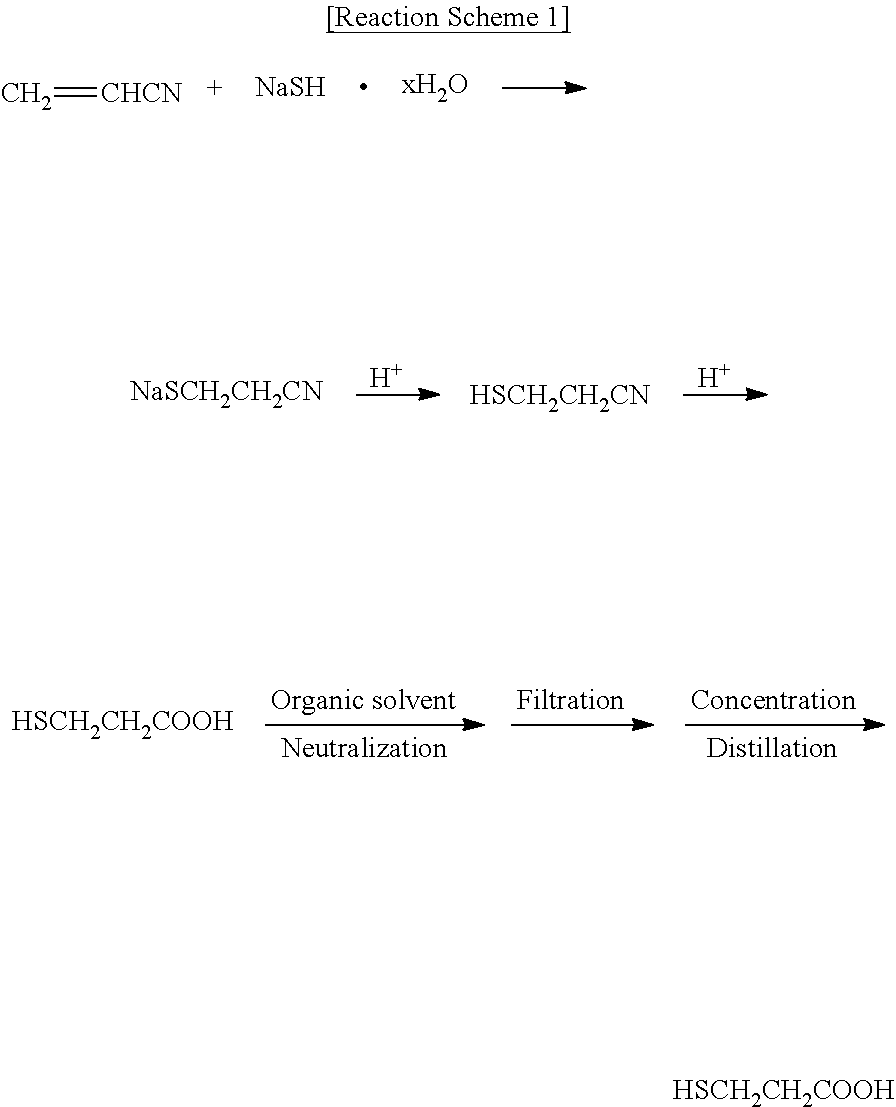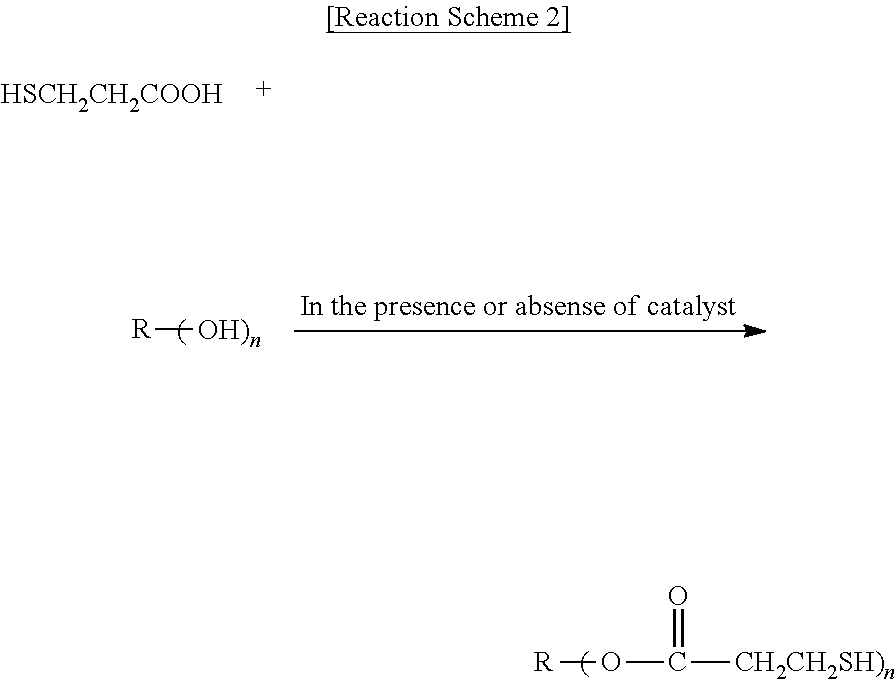Method for producing 3-mercaptopropionic acid, and methods using same for producing carboxylic acid ester compound having mercapto group and thiourethane-based optical material
a technology of mercapto group and ester compound, which is applied in the direction of optical elements, instruments, organic chemistry, etc., can solve the problems of undesired composition of products and by-products, complicated preparation process, and high production cost, and achieve excellent purity and color, reduce pressure, and low cost
- Summary
- Abstract
- Description
- Claims
- Application Information
AI Technical Summary
Benefits of technology
Problems solved by technology
Method used
Image
Examples
synthesis example 1
[0061]3-Mercaptopropionic Acid (MPA-1)
[0062]A stirrer, a thermometer and a condenser were installed on a 1 L four-neck flask and NaSH.xH2O (70%, 165.24 g, 2.65 moles) was charged in the flask and 160 g of water was added thereto and completely dissolved by stirring at 30° C. for 30 minutes. Then, while maintaining the temperature at 35° C., acrylonitrile (106.12 g, 2.00 moles) was slowly added dropwise. As heating occurred, the reaction proceeded. After the entirety of acrylonitrile was added, aging was conducted at 60° C. for 8 hours to obtain 2-sodium cyanoethanethiolate. The product was identified by GC analysis. After the starting material completely disappeared, 3-mercaptopropionitrile obtained by neutralizing the product, 2-sodium cyanoethanethiolate, was identified by GC analysis. After the reaction was completed, the temperature of the reactor was dropped to 10° C. and the reaction solution was neutralized while slowly dropwise adding concentrated hydrochloric acid at a temp...
synthesis example 2
3-Mercaptopropionic Acid (MPA-2)
[0063]A stirrer, a thermometer and a condenser were installed on a 1 L four-neck flask and NaSH.xH2O (70%, 177.79 g, 2.22 moles) was charged in the flask and 160 g of waster was added thereto and completely dissolved by stirring at 40° C. for 30 minutes. Then, while maintaining the temperature at 35° C., acrylonitrile (106.12 g, 2.00 moles) was slowly added. As heating occurred, the reaction proceeded. After the entirety of acrylonitrile was added, aging was conducted at 50° C. for 10 hours and stirring was conducted at the same temperature to obtain 2-sodium cyanoethanethiolate. 3-mercaptopropionitrile obtained by neutralizing the product, 2-sodium cyanoethanethiolate, was identified by GC analysis. After the reaction was completed, the temperature of the reactor was dropped to 10° C. and 3-mercaptopropionitrile produced by neutralization with concentrated hydrochloric acid was separated into the organic layer as the upper layer. The aqueous layer, t...
synthesis example 3
[0068]Trimethylolpropane tris(3-mercaptopropionate) (TMPMP-1)
[0069]A stirrer, a thermometer and a Dean-Stark apparatus were installed on a 1 L four-neck flask, 0.5 moles (67.08 g) of trimethylolpropane was added, 3 moles (318.42 g) of the 3-mercaptopropionic acid (MPA-1) obtained in Synthesis Example 1 was added thereto, 100 g of toluene was added as a solvent thereto, and the flask was installed in an oil bath and then heated. The temperature of the oil was elevated to 150° C. Water started to be produced around an inner temperature of 120° C. and reaction proceeded for 24 hours. Then, when production of water was almost not observed, the solvent and an excess of 3-mercaptopropionic acid were collected by distillation under reduced pressure. LC analysis results showed that the unreacted substance, trimethylolpropane, did not appear and the purity of the product was 88% and the amount of product obtained was 195.28 g. The index of refraction (nE) of the product was 1.518 and the col...
PUM
| Property | Measurement | Unit |
|---|---|---|
| temperature | aaaaa | aaaaa |
| temperature | aaaaa | aaaaa |
| temperature | aaaaa | aaaaa |
Abstract
Description
Claims
Application Information
 Login to View More
Login to View More - R&D
- Intellectual Property
- Life Sciences
- Materials
- Tech Scout
- Unparalleled Data Quality
- Higher Quality Content
- 60% Fewer Hallucinations
Browse by: Latest US Patents, China's latest patents, Technical Efficacy Thesaurus, Application Domain, Technology Topic, Popular Technical Reports.
© 2025 PatSnap. All rights reserved.Legal|Privacy policy|Modern Slavery Act Transparency Statement|Sitemap|About US| Contact US: help@patsnap.com


